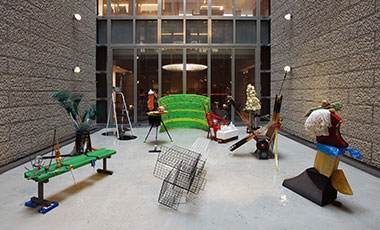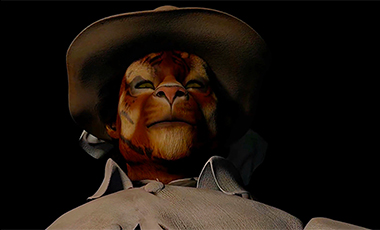I’m looking at a dishevelled Nam June Paik wriggling inside a hollow television set, mussy hair, confused expression, tie askew. Knocking urgently on the glass, he exclaims contentedly: “I’m tired!” This was a live telecast across the world from Documenta 6, an innovation of broadcast history in the arts, the ensuing bedlam bookended by a nervous introduction from an anxious-looking television executive, and an intense monologue by aJoseph Beuys. This wonderful, maze like retrospective at the Tate Modern’s Eyal Ofer galleries does a good job of recreating the playful mayhem of Korean-born artist Nam June Paik, whose genre-crossing brand of libertarianism did to TV, modern art and music what Bruegel and Bosch had once done on canvas. You’ll be here to stay: visitors should budget a full afternoon—whether it’s raining or not—to enjoy the variety to the utmost.

Nam June Paik at Tate Modern, 2019, install view. All works by Nam June Paik © Estate of Nam June Paik. Photo credit: Andrew Dunkley ©Tate.
Paik was proud of his heritage and perhaps intended for his gleeful artistic offensives to be perceived in light of those original invading iconoclasts. However, the artist’s style is affable and merry rather than ferocious. His role for much of this show is that of a genial host presiding over an anarchic party of avant-garde musical and artistic luminaries of his age. There is a 1960 photo of a grinning John Cage, his tie cut off by Paik and shampoo poured over his head, and another of Beuys destroying one of the artist’s specially modified pianos (a spontaneous act which was met with Paik’s wholehearted approval). Cage, in fact, was such a significant influence on Paik that Paik referred to the year 1957 as 1 BC (Before Cage).

TV Cello 1971. Install view, Tate Modern 2019, three cathode-ray tubes, acrylic boxes, three television casings, electronics, wiring, wood base, fan and stool. Walker Art Center, T. B. Walker Acquisition Fund, 1992, Minneapolis. Formerly the collection of Otto Piene and Elizabeth Goldring, Massachusetts. All works by Nam June Paik © Estate of Nam June Paik. Photo credit: Andrew Dunkley ©Tate.

Nam June Paik at Tate Modern, 2019, install view. All works by Nam June Paik © Estate of Nam June Paik. Photo credit: Andrew Dunkley ©Tate.
Several of his closest collaborators and friends were trail-blazing women such as the “naked cellist” Charlotte Moorman, who felt, like Paik, that sex was insufficiently investigated as a theme in classical music (unlike in literature and art for example) and sought to rectify this with artworks such as TV Bra for Living Sculpture (1969), TV Cello (1971), and TV Bed (1972). Would the TV bed get too hot and bright to sleep on? It looks so fun, one hardly cares. Paik loved performance, and sex was the ultimate performance art. His Fluxus-inspired Serenade for Alison (1962) opens with: “Take off a pair of yellow panties, and put them on the wall,”—followed by eight more instructions, all beginning with “Take off.”
The show underlines Paik’s unpretentious ability to pluck gems of creativity from whatever medium or age he could find them, a mish-mash which foreshadowed the experience one might have now hopping through a hundred TV channels. Video works like Global Groove (1973) show the artist’s interest in synthesizing cultural components from East, West, past, present, music, art and technology and thereby launching an aerial assault on the viewer’s senses.
Ahead of the Internet age, Paik wanted the public to feel not intimidated by technology, but able to harness it, to make fun of it, and to own its development. Works like Three Camera Participation (1969) allow us to star in a hallucinogenic carnival of colour and movement. Other earlier, simpler works like Foot Switch Experiment and Random Access (both 1963) are attempts to make technology more human by such simple interactions as stepping on a button to switch a screen on and off. In another room, friendly anthropomorphized televisions loom above us, leering with brightly-lit faces in Family of Robot (1986). In the eyes of a contemporary audience, these belong to a mechanical, industrial age rather than the age of the Internet. Paik periodically found commercial opportunities to drive his innovation onwards, working extensively at Bell Labs in 1966 and as artist-in-residence at WGBH Boston in 1969. The former proved disappointing because Paik became conscious of the limits of contemporary technology. Although Paik predominantly used technology as a means to unify a panoply of influences, it would be interesting to have seen his work developing in the Internet era.

TV Garden 1974-1977 (2002). Install view, Tate Modern 2019. Live plants, cathode-ray tube televisions and video, colour, sound, installation dimensions variable. Kunstsammlung Nordrhein-Westfalen, Dusseldorf. All works by Nam June Paik © Estate of Nam June Paik. Photo credit: Andrew Dunkley ©Tate.
Paik is quoted in the show with his words from 1992: “Television has attacked us for a lifetime, now, we strike back.” However, the feeling overall is one of affectionate and harmonious unity with the TV screen. TV Garden (1974-77) at the entrance to the exhibition is a potent illustration of this, as television sets lie in the ground like marrows in the midst of evergreen fronds. Another, more low key example of the television’s journey to the heart of the human experience is the 1974 watercolour on paper It rains in my TV as it rains in my heart—romantic lines snatched and adapted from 20th Century French poet Verlaine: “Il pleure dans mon coeur, comme il pleut sur la ville…” romantically depicting the changing moods of a city and linking them with his own emotional state. Paik now replaces the real world with the TV as the poetic lens of the pathetic fallacy. Paik’s appreciation of the TV as a way of joining us in community continues to be felt now when series finales are on TV, or giant sporting events such as the World Cup or the Olympic Games.
Nam June Paik
17 October 2019 – 9 February 2020
Tate Modern, London

Related Articles:
Interview with the Tate Modern Seniro Curator on Staging 'Retrospective on Nam June Paik
The Raucous and Fredetic Energy of Nam June Paik, Hyperallergic
※ Click to Read the Full Article on CoBo Social: The Sun Always Shines on TV: Nam June Paik at Tate Modern (https://www.cobosocial.com/dossiers/nam-june-paik-at-tate-modern/)
※ This article was originally published in CoBo Social(https://www.cobosocial.com) on 12 DEC 2019 and reposted under authority of a partnership between KAMS and CoBo Social.

Nicholas Stephens
Writer. Nicholas Stephens is from London and has lived in Hong Kong for the last nine years, where he works for a leading Hong Kong gallery, specializing in contemporary ink. His articles on diverse aspects of the Hong Kong arts scene have been published in “Art Hong Kong”. A graduate in Modern Languages (European ones unfortunately!), Nicholas has authored translations of novels and plays by writers including Stefan Zweig and Hugo von Hofmannsthal.


